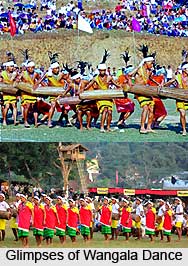 Wangala dance is practiced in the Meghalaya state of India. This dance is basically a part of the Wangala Festival which is celebrated in the honour of the Saljong, the Sun-god of fertility. Also known as `100 Drum Festival`, it is celebrated as the annual harvest festival. This is one of the most significant festivals of Meghalaya which marks the beginning of winter season and end of the toiling period which brings the output of the field at the end of the year. This festival includes a number of sacrifices offered by the tribal people to please their main deity Saljong - the Sun God.
Wangala dance is practiced in the Meghalaya state of India. This dance is basically a part of the Wangala Festival which is celebrated in the honour of the Saljong, the Sun-god of fertility. Also known as `100 Drum Festival`, it is celebrated as the annual harvest festival. This is one of the most significant festivals of Meghalaya which marks the beginning of winter season and end of the toiling period which brings the output of the field at the end of the year. This festival includes a number of sacrifices offered by the tribal people to please their main deity Saljong - the Sun God.
Performance of Wangala Dance
The festival lasts from two days to a week. On the first day, the festival focuses on the ceremony of "Ragula" while on the second day Kakkat is performed. People from all age group participate in this festival. Along with their feathered headgears they dance on the tunes of the oval shaped drums. The sounds of the drums create a mesmerising effect. People are comfortable and relaxed to participate forgetting all worries. In this dance festival, queen of two parallel lines - one of men while the other is of women are presented who dance with complete perfection. The group moves in a line to the rhythm of the drums which are played in a particular tune.
Wangala dance festival is also known for the type of music played. The music attracts the visitors toward the rhythmic tunes that are echoed in the mountainous region of Meghalaya. In addition to drums, the other musical instruments played to accompany this dance comprise of gong and flutes made up of buffalo horns. Wangala dance festival is usually held in the caves of Garo hills. These are also known as Dobakhol or Cave of the Bats that has large deposits of stalagmites which are formed in centuries.
Thus, with its colourful carnival, it is one of the most popular festivals of Meghalaya. It is not only celebrated to pay homage to the god of harvest and agriculture for a splendid crop of the season and golden harvest but also celebrated to welcome the new season with full energy and freshness.



















